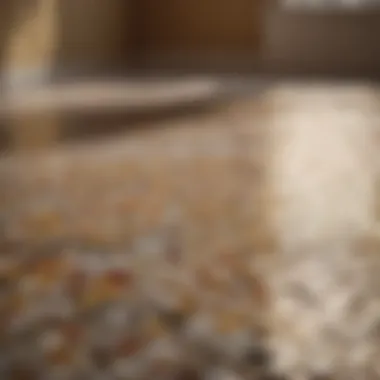Unveiling the Detailed Cost Analysis of Tiling a Bathroom Floor and Shower


Materials:
To start your tiling project for the bathroom floor and shower, an array of materials will be required. Here is a detailed list itemizing each material along with precise measurements:
- Tiles: High-quality ceramic or porcelain tiles measuring 12x12 inches for the floor and 8x10 inches for the shower.
- Grout: A sufficient amount of grout in a color that complements the tiles, ensuring proper adhesion.
- Adhesive: Tile adhesive suitable for the type and size of tiles being used.
- Waterproofing Membrane: A waterproofing membrane to prevent water damage and ensure longevity.
- Spacers: Tile spacers for maintaining consistent spacing between tiles.
- Sealer: A durable sealer to protect the tiles and grout from moisture and staining.
- Trowel: A notch trowel for spreading adhesive evenly and efficiently.
- Float: A grout float for applying grout smoothly and effectively.
- Sponge: A damp sponge for cleaning excess grout and achieving a polished finish.
- Level: A level tool to ensure tiles are laid perfectly straight.
- Bucket: A bucket for mixing grout and adhesive thoroughly.
DIY Steps:
Once you have gathered all the necessary materials, it's time to embark on the tiling process with detailed instructions:
- Prepare the Surface: Ensure the bathroom floor and shower walls are clean, smooth, and dry before proceeding with tiling.
- Layout Design: Plan the layout of the tiles, considering patterns, corners, and edges for a visually appealing finish.
- Apply Adhesive: Spread tile adhesive evenly on the surface using the notch trowel, working in small sections.
- Lay Tiles: Place tiles carefully, using spacers to maintain consistent gaps between them for a professional look.
- Grout Application: After the adhesive has set, apply grout with a float, working it into the spaces between tiles.
- Sealing Process: Once the grout has dried, seal the tiles and grout to protect them from moisture and stains.
- Final Touches: Clean excess grout with a damp sponge, double-checking for any imperfections or uneven tiles.
Technical Aspects:
Beyond the materials and steps, understanding the technical aspects is crucial for a successful tiling project:
- Tool Requirements: Have tools such as a tile cutter, rubber mallet, and tile nipper for precise cuts and adjustments.
- Timing Specifics: Allow ample time for adhesive and grout to set before walking on the tiled surfaces or using the shower.
- Critical Techniques: Learn how to cut tiles to fit corners and edges, as well as how to achieve uniform grout lines for a professional finish.
DIY Project Process:
As you progress through the tiling process, follow these sequential steps for a seamless installation:
- Start with the Floor: Begin tiling the bathroom floor, working from the center outwards to ensure even tile placement.
- Move to the Shower: Once the floor is tiled, proceed to tile the shower walls, paying attention to waterproofing and drainage areas.
- Troubleshooting Tips: In case of misaligned tiles or uneven grout, use a grout removal tool for adjustments and a smoother finish. Remember to double-check measurements and alignments throughout the project to avoid costly errors.
Materials Costs
In the realm of tiling a bathroom floor and shower, one of the pivotal elements to consider is the Materials Costs. This section plays a crucial role in the overall budget estimation for the project, encompassing various components such as tiles, grout, adhesive, and underlayment. Understanding the intricacies of Materials Costs enables individuals to make well-informed decisions and ensures they can budget effectively for their tiling endeavor.
Tile Costs


Choosing the Right Tile Type
Choosing the Right Tile Type is a fundamental decision in the tiling process. It involves evaluating factors such as material, durability, design, and maintenance requirements. Opting for high-quality tiles can enhance the aesthetic appeal and longevity of the bathroom floor and shower. Ceramic, porcelain, marble, and mosaic are popular choices, each offering unique characteristics to suit different preferences.
Calculating Tile Quantity
Accurately calculating the tile quantity is essential for estimating the required materials and cost. This involves measuring the area to be tiled and factoring in potential wastage. By conducting precise calculations, individuals can avoid unnecessary expenses and ensure they have adequate tiles for the project.
Estimating Tile Costs per Square Foot
Estimating the Tile Costs per square foot involves assessing the price of tiles based on material, size, brand, and design. It is essential to consider both the cost of individual tiles and the total cost per square foot to budget effectively. Comparing prices from different suppliers can help individuals secure the best deals and maximize their budget for tiling.
Grout and Adhesive Costs
Types of Grout and Adhesive
The selection of appropriate grout and adhesive is crucial for achieving a durable and visually appealing finish. Individuals can choose from various types such as sanded, unsanded, epoxy, and acrylic grout, each offering specific benefits in terms of strength and water resistance. Similarly, different adhesive products cater to various tile materials and installation requirements, ensuring a secure bond between the tiles and the surface.
Pricing of Grout and Adhesive Products
Determining the pricing of grout and adhesive products involves considering factors like quality, quantity, and brand. While higher-priced products may offer enhanced performance and durability, individuals can also find cost-effective options without compromising on quality. By comparing prices and assessing the suitability of products, individuals can make informed decisions to accommodate their budget effectively.
Underlayment Expenses
Need for Underlayment
Underlayment serves as a foundation for the tile installation, providing support, waterproofing, and insulation. The need for underlayment depends on factors like existing subfloor condition, tile material, and desired finish. Utilizing underlayment enhances the longevity of the tiles and ensures a stable surface for installation, reducing the risk of damage over time.
Cost Considerations for Underlayment
Considering the cost implications of underlayment is essential for overall budget planning. Factors such as material cost, installation labor, and additional waterproofing measures contribute to the total expenses. While investing in high-quality underlayment may incur initial costs, it can prevent future repairs and enhance the overall performance of the tiled area.
Labor Costs


In the realm of tiling a bathroom floor and shower, labor costs play a vital role in the overall budget allocation. Understanding the significance of labor costs is crucial for individuals undertaking a tiling project. Labor costs encompass the expenses associated with hiring professionals or investing time and effort in a do-it-yourself approach. This section delves into the specifics of labor costs, shedding light on the factors that impact pricing and budget considerations.
Professional Installation Costs
Hiring a Tiling Professional
Hiring a tiling professional is a pivotal decision in the tiling process, as it can significantly affect the outcome of the project. Engaging a seasoned professional ensures expertise, precision, and efficient completion of the tiling job. The key characteristic of hiring a tiling professional lies in their specialized skill set and experience, equipping them to handle complex tiling tasks with finesse. Opting for a professional guarantees a high-quality finish, timely execution, and adherence to industry standards. While the cost of hiring a tiling professional may be higher than a DIY approach, the advantages of superior craftsmanship and peace of mind justify the investment. However, it is essential to carefully assess the credentials and reputation of the tiling professional to ensure a satisfactory outcome.
Average Labor Costs per Square Foot
When evaluating the cost of labor per square foot, it is essential to consider the intricacies involved in tiling a bathroom floor and shower. The average labor costs encompass the charges incurred for the labor-intensive aspects of the tiling process, including surface preparation, tile installation, grouting, and sealing. The key characteristic of average labor costs per square foot lies in providing a comprehensive overview of the expected expenses related to the workforce involved. This pricing factor is a popular choice for individuals seeking clarity on the labor component of their tiling project, enabling better budget planning and cost estimation. While opting for professional labor may increase the overall project cost, the advantages of efficient workmanship, time-saving benefits, and professional finish make it a favorable option for those prioritizing quality and precision in their tiling endeavors.
DIY Installation Expenses
Tools and Equipment Costs
Considering the tools and equipment required for a DIY tiling project is crucial for individuals aiming to tackle the installation themselves. Tools and equipment costs encompass the expenses associated with acquiring essential tiling tools such as tile cutters, trowels, spacers, and leveling systems. The key characteristic of tools and equipment costs is their role in facilitating a seamless tiling process, ensuring accuracy and efficiency in tile placement and alignment. Opting for a DIY approach allows homeowners to personalize their tiling project according to their preferences and timeline. While the initial investment in tools may seem daunting, the advantages of creative control, learning opportunities, and cost savings in terms of labor expenses make it a popular choice among DIY enthusiasts.
Time and Effort Considerations
Evaluating the time and effort required for a DIY tiling project is essential for individuals charting their tiling journey. Time and effort considerations encompass the dedication and energy needed to plan, execute, and complete the tiling process independently. The key characteristic of time and effort considerations lies in the personal investment required to achieve the desired tiling outcome. Opting for a DIY approach allows homeowners to engage in a hands-on project, fostering a sense of accomplishment and ownership upon completion. While DIY projects demand patience, perseverance, and attention to detail, the advantages of customization, cost-effectiveness, and skill development make them a rewarding option for individuals passionate about home improvement initiatives.
Additional Expenses
In the realm of tiling a bathroom floor and shower, attending to additional expenses is a critical component that requires meticulous attention. These expenses go beyond the core materials and labor costs, encompassing crucial aspects that ensure the project's success and longevity. By delving into the details of additional expenses, homeowners can develop a thorough understanding of the financial considerations involved in the tiling process, allowing for informed decision-making and effective budget management.
When considering additional expenses, several key elements merit consideration. Firstly, the need for proper sealing stands out as a non-negotiable expense to protect the tiled surfaces from moisture penetration and damage. Moreover, waste disposal fees play a significant role in ensuring environmentally responsible practices during the renovation process.
Furthermore, miscellaneous costs, such as unexpected expenses that may arise unexpectedly during the project, highlight the importance of setting aside a contingency budget to accommodate unforeseen circumstances. By addressing these additional expenses proactively, homeowners can mitigate risks and enhance the overall success of their tiling project.
Sealing Costs
Importance of Sealing


The significance of sealing in the context of tiling a bathroom floor and shower cannot be overstated. Proper sealing serves as a protective barrier against water intrusion, preventing potential leaks and mold growth that can compromise the structural integrity of the tiled surfaces. Emphasizing the importance of sealing underscores its role in prolonging the lifespan of the tiles and maintaining the aesthetic appeal of the bathroom.
Effective sealing also contributes to the overall waterproofing of the bathroom, ensuring a hygienic environment free from moisture-related issues. By investing in quality sealant products and meticulous application processes, homeowners can safeguard their tiling investment for years to come.
Sealant Products and Pricing
When exploring sealant products and pricing, homeowners are presented with a myriad of options catering to various preferences and budget constraints. High-quality sealants boast superior water resistance properties and durability, providing long-lasting protection for tiled surfaces in wet areas.
Considering the diverse range of sealant products available in the market, homeowners can choose formulations that align with their specific needs, whether it be enhanced stain resistance or anti-microbial properties. While pricing may vary based on the quality and brand of the sealants, investing in premium products ensures optimal performance and longevity for the tiled surfaces.
With an array of sealant options to select from, homeowners can tailor their choices based on the desired level of protection and aesthetic preferences, ultimately enhancing the overall quality and durability of the tiling installation.
Waste Disposal Fees
Proper Waste Removal
Proper waste removal in the context of tiling a bathroom floor and shower is a fundamental aspect that contributes to a sustainable and eco-friendly renovation process. By adhering to responsible waste disposal practices, homeowners not only minimize their environmental impact but also ensure compliance with local regulations and ordinances.
Prioritizing proper waste removal involves disposing of construction debris and discarded materials in designated receptacles or recycling facilities to prevent pollution and promote resource conservation. By engaging in conscientious waste management strategies, homeowners can contribute to a cleaner and healthier environment while supporting sustainable building practices.
Potential Disposal Costs
Understanding the potential disposal costs associated with tiling projects is essential for effective budget planning and cost estimation. These costs encompass fees related to waste collection, transportation, and disposal, which may vary depending on the quantity and type of waste generated during the renovation process.
By accounting for potential disposal costs upfront, homeowners can avoid financial surprises and allocate resources accordingly. Collaborating with reputable waste management services ensures proper disposal procedures and adherence to waste disposal regulations, fostering a seamless and environmentally responsible tiling experience.
Miscellaneous Costs
Unexpected Expenses
Unforeseen circumstances and unexpected expenses are unavoidable realities in any home improvement project, including tiling a bathroom floor and shower. As such, incorporating a contingency budget to accommodate unexpected costs is a prudent approach to safeguarding against financial setbacks and project delays.
Unexpected expenses may stem from hidden structural issues, material shortages, or unforeseen installation challenges, underscoring the importance of financial preparedness and risk mitigation. By allocating a contingency budget, homeowners can navigate unforeseen hurdles with confidence and ensure the successful completion of their tiling project.
Contingency Budgeting
Contingency budgeting emerges as a strategic financial tool that empowers homeowners to address uncertainties and fluctuations in project costs effectively. Setting aside a contingency fund, typically ranging from 10% to 20% of the total project budget, provides a safety net for absorbing unexpected expenses without compromising the project's quality or timeline.
By embracing contingency budgeting as a proactive measure, homeowners exhibit financial prudence and foresight in managing project risks. This approach instills peace of mind and resilience, allowing for agile responses to unpredictable events and enhancing the overall outcome of the tiling endeavor.







